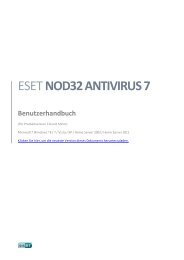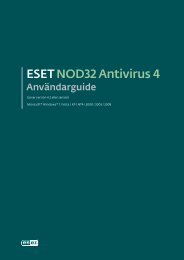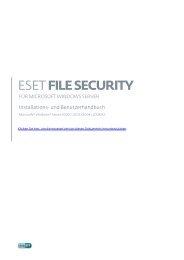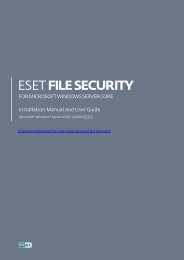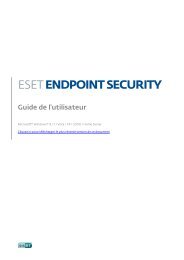ESET File Security Installation Manual and User Guide
ESET File Security Installation Manual and User Guide
ESET File Security Installation Manual and User Guide
You also want an ePaper? Increase the reach of your titles
YUMPU automatically turns print PDFs into web optimized ePapers that Google loves.
[dac]<br />
agent_enabled = yes<br />
event_mask = "open"<br />
ctl_incl = "/home"<br />
action_av = "scan"<br />
user_config = "esets_dac_spec.cfg"<br />
Once the ‘user_config’ file parameter is specified within the [dac] section, the ‘esets_dac_spec.cfg’ file must be created in the <strong>ESET</strong>S<br />
configuration directory. Finally, add the desired scanning rules.<br />
[username]<br />
action_av = "reject"<br />
At the top of the special section, enter the username to which the individual rules will be applied. This configuration will allow<br />
all other users attempting to access the file-system to be processed normally. i.e., all file system objects accessed by other users<br />
will be scanned for infiltrations, except for the user ‘username’, whose access will be rejected (blocked).<br />
7.3 Samples Submission System<br />
The Samples submission system is an intelligent ThreatSense.Net technology that collects infected objects that have been<br />
detected by advanced heuristics <strong>and</strong> delivers them to the samples submission system server. All virus samples collected by the<br />
sample submission system will be processed by the <strong>ESET</strong> virus laboratory <strong>and</strong> if necessary, added to the <strong>ESET</strong> virus signature<br />
database.<br />
Note: According to our license agreement, by enabling the sample submission system you are agreeing to allow the computer<br />
<strong>and</strong>/or platform on which the esets_daemon is installed to collect data (which may include personal information about you<br />
<strong>and</strong>/or other users of the computer) <strong>and</strong> samples of newly detected viruses or other threats <strong>and</strong> send them to <strong>ESET</strong> virus<br />
laboratory. This feature is disabled by default. All information collected will be used only to analyze new threats <strong>and</strong> will not be<br />
used for any other purpose.<br />
In order to enable sampling, the samples submission system cache must be initialized. This can be achieved by selecting<br />
‘samples_enabled’ in the [global] section of the <strong>ESET</strong>S configuration file.<br />
For more information on the Samples Submission System <strong>and</strong> its options, please refer to the esets_daemon(8) mane page.<br />
7.4 Scheduler<br />
The Scheduler's functionality includes running scheduled tasks at a specified time or on a specific event, managing <strong>and</strong><br />
launching tasks with predefined configuration <strong>and</strong> properties <strong>and</strong> more. Task configuration <strong>and</strong> properties can be used to<br />
influence launch dates <strong>and</strong> times, but also to exp<strong>and</strong> the application of tasks by introducing the use of custom profiles during<br />
task execution.<br />
The ‘scheduler_tasks’ option is commented by default, causing the default scheduler configuration to be applied. In the <strong>ESET</strong>S<br />
configuration file all parameters <strong>and</strong> tasks are semicolon-separated. Any other semicolons (<strong>and</strong> backslashes) must be<br />
backslash escaped. Each task has 6 parameters <strong>and</strong> the syntax is as follows:<br />
id – Unique number.<br />
name – Task description.<br />
flags – Special flags to disable the specified scheduler task can be set here.<br />
failstart – Instructs what to do if task could not be run on scheduled date.<br />
datespec – A regular date specification with 6 (crontab like year-extended) fields, recurrent date or an event name option.<br />
comm<strong>and</strong> – Can be an absolute path to a comm<strong>and</strong> followed by its arguments or a special comm<strong>and</strong> name with the ‘@’ prefix<br />
(e.g. anti-virus update: @update).<br />
#scheduler_tasks = "id;name;flags;failstart;datespec;comm<strong>and</strong>;id2;name2;...";<br />
The following event names can be used in place of the datespec option:<br />
start – Daemon startup.<br />
startonce – Daemon startup but at most once a day.<br />
engine – Successful engine update.<br />
login – Web interface logon startup.<br />
threat – Threat detected.<br />
notscanned – Not scanned email or file.<br />
licexp – 30 days before license expiration.<br />
To display the current scheduler configuration, use the Web interface or run the following comm<strong>and</strong>:<br />
cat @ETCDIR@/esets.cfg | grep scheduler_tasks<br />
For a full description of Scheduler <strong>and</strong> its parameters refer to the Scheduler section of the esets_daemon(8) man page.<br />
15



